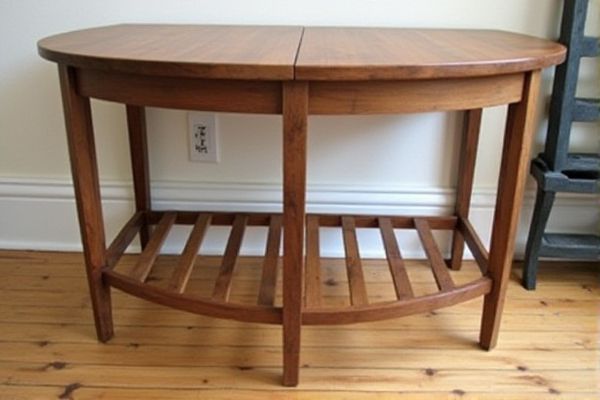
Drop-leaf tables have fixed legs with hinged leaves that fold down for space-saving, while gateleg tables feature hinged legs that swing out to support the leaves, providing extra stability. Discover how to choose the perfect table to fit your room's layout and enhance Your living space by exploring the full article.
Table of Comparison
| Feature | Drop-leaf Table | Gateleg Table |
|---|---|---|
| Design | Fixed center with hinged leaves on sides | Leaves supported by swinging legs (gates) |
| Support Mechanism | Leaves fold down vertically; requires external support when extended | Swinging legs provide support when leaves are extended |
| Space Efficiency | Compact when leaves are down, suitable for small spaces | Compact and stable; ideal for variable space needs |
| Stability | Stable but leaves can be less secure without supports | Highly stable due to leg support |
| Usage | Commonly used as dining or side table | Versatile for dining, working, and occasional use |
| Historical Origin | 17th century England, traditional design | 16th century England, evolved from hall tables |
Introduction to Drop-Leaf and Gateleg Tables
Drop-leaf tables feature hinged sections on either side that fold down to save space, making them ideal for small rooms or flexible layouts. Gateleg tables include hinged leaves supported by swinging legs, offering greater stability when extended and varying height options. Both designs optimize space by allowing expansion when needed and compact storage when not in use.
Historical Origins and Evolution
Drop-leaf tables originated in 16th-century Europe, designed for space-saving functionality with hinged leaves that could be folded down. Gateleg tables, evolving slightly later in the 17th century, featured swinging legs or "gates" that supported the extended leaves, enhancing stability and usability. Both designs reflect historical shifts in domestic furniture adapting to variable room sizes and multifunctional uses.
Defining Features of Drop-Leaf Tables
Drop-leaf tables are characterized by hinged sections, or "leaves," that can be folded down to save space or extended for additional surface area, making them ideal for compact living spaces. These tables typically have two drop leaves on either side of a central fixed section, supported by brackets or hinged legs when raised. Unlike gateleg tables, drop-leaf tables do not have swinging legs and rely on structural brackets to hold the leaves securely.
Defining Features of Gateleg Tables
Gateleg tables feature hinged leaves supported by swinging legs or "gates" that fold under the table when not in use, providing enhanced stability compared to drop-leaf tables with simple brackets. The distinctive gateleg mechanism allows one or both sides of the tabletop to extend, making it ideal for flexible dining or workspace arrangements. These tables often showcase traditional craftsmanship with robust wooden frames and a more intricate support system than basic drop-leaf designs.
Functional Differences and Use Cases
Drop-leaf tables feature hinged sections that can be folded down to save space, ideal for small rooms or flexible layouts. Gateleg tables have swinging legs that support the leaves when extended, offering greater stability for larger gatherings or dining areas. Drop-leaf tables suit casual settings and versatile use, while gateleg tables excel in providing sturdy surfaces for formal meals or workspaces.
Space-Saving Benefits: Drop-Leaf vs Gateleg
Drop-leaf tables offer space-saving benefits through hinged leaves that fold down flat, making them ideal for small areas and easy storage. Gateleg tables maximize floor space by having legs that swing out to support the leaves, providing extra stability when extended and compactness when folded. Your choice depends on whether you prioritize a simpler, sleeker design or more robust support and versatility in a limited space.
Aesthetic and Design Variations
Drop-leaf tables feature a simple, minimalist design with hinged leaves that fold down on either side, offering a clean and versatile aesthetic ideal for modern or casual spaces. Gateleg tables showcase a more traditional and ornate style, characterized by swing-out legs that support the leaves, often adding a sense of craftsmanship and classic charm to your room. Your choice between these designs depends on whether you prefer sleek functionality or decorative elegance to complement your interior decor.
Durability and Construction Comparison
Drop-leaf tables typically feature fixed legs with hinged leaves that fold down, offering moderate durability due to their simpler construction. Gateleg tables employ swinging legs that pivot to support the leaves, providing enhanced stability and strength suitable for heavier use. Your choice depends on whether you prioritize straightforward design or robust support for long-term durability.
Maintenance and Care Tips
Drop-leaf tables require regular tightening of hinge screws and occasional polishing of wooden surfaces to prevent wear and maintain smooth operation. Gateleg tables demand careful inspection of the swinging legs and joints to ensure stability, with periodic lubrication of hinges to avoid squeaking and ease folding. Both table types benefit from using coasters and protective pads to minimize surface damage and extend longevity.
Choosing the Right Table for Your Home
Drop-leaf tables feature hinged leaves that fold down to save space, ideal for compact rooms where flexibility is key, while gateleg tables include swinging legs that support the leaves when extended, offering greater stability for larger gatherings. Consider the size of your space and how often you entertain; gateleg tables provide more support for heavier use, whereas drop-leaf tables are easier to move and adapt. Your choice depends on balancing daily space-saving needs with occasional expansion for guests.
 homyna.com
homyna.com